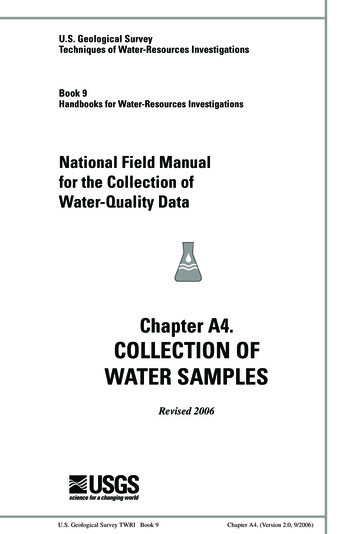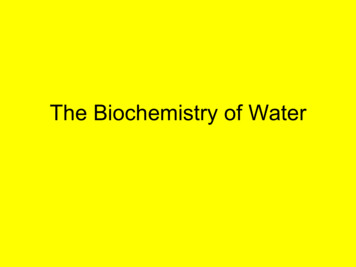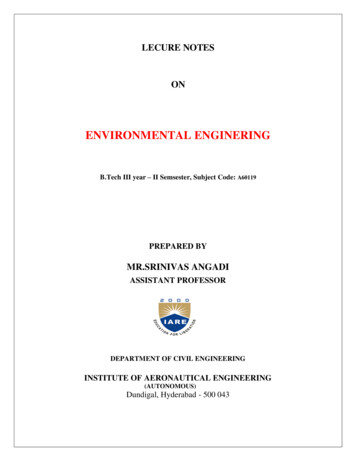
Transcription
U.S. Geological SurveyTechniques of Water-Resources InvestigationsBook 9Handbooks for Water-Resources InvestigationsNational Field Manualfor the Collection ofWater-Quality DataChapter A4.COLLECTION OFWATER SAMPLESRevised 2006U.S. Geological Survey TWRI Book 9Chapter A4. (Version 2.0, 9/2006)
U.S. DEPARTMENT OF THE INTERIORDIRK KEMPTHORNE, SecretaryU.S. GEOLOGICAL SURVEYMark D. Myers, DirectorAny use of trade, product, or firm names is for descriptive purposesonly and does not imply endorsement by the U.S. Government.For additional information write to:Chief, Office of Water QualityU.S. Geological Survey12201 Sunrise Valley DriveMail Stop 412Reston, VA 20192This report is accessible online at http://pubs.water.usgs.gov/twri9A/Chapter A4. (Version 2.0, 9/2006)U.S. Geological Survey TWRI Book 9
ForewordThe mission of the W ater Resour ces Dis cipline of the U.S.Geological Surv ey (USGS) is to pro vide the information andunderstanding needed for wise management of the Nation’swater resources. Inherent in this mission is the responsibility tocollect data that accurately describe the physical, chemical, andbiological attributes of water systems. These data ar e used forenvironmental an d resource asses sments b y the USGS, othergovernment agencies and scie ntific or ganizations, and thegeneral public. Reliable and quality-assured data are essential tothe credibility and impartiality of the water-resources appraisalscarried out by the USGS.The de velopment and use of a National Field Manual isnecessary to achie ve consistency in the scientif ic methods andprocedures used, to document those methods an d procedures,and to maintain technical e xpertise. USGS f ield personnel usethis manual to e nsure that the da ta collected are of the qualityrequired to fulfill our mission.Robert M. HirschAssociate Director for WaterU.S. Geological Survey TWRI Book 9Chapter A4. (Version 2.0, 9/2006)
Techniques of Water-Resources InvestigationsPage intentially left blank.Chapter A4. (Version 2.0, 9/2006)U.S. Geological Survey TWRI Book 9
COLLECTION OF WATER SAMPLES— 1National Field Manualfor the Collection ofWater-Quality DataChapter A4.COLLECTION OFWATER SAMPLESPageAbstract .7Introduction .8Purpose and scope .8Requirements and recommendations.9Field manual review and revision.10Acknowledgments.10A4. Collection of Water Samples .114.0 Responsibilities, field preparations, andpreventing sample contamination .134.0.1 Responsibilities and field preparations .144.0.2 Preventing sample contamination .194.1 Surface-water sampling .254.1.1 Site files.264.1.1.A NWIS files.264.1.1.B Field folders .284.1.2 Selection of surface-water sampling sites .304.1.2.A Flowing-water sites .314.1.2.B Still-water sites .33Collection of Water Samples (Version 2.0, 9/2006)Chapter A4. Contents
2 — COLLECTION OF WATER SAMPLES4.1.3 Sampling at flowing-water and still-water sites. 334.1.3.A Isokinetic, depth-integrated samplingmethods at flowing-water sites. 37Equal-width-increment method . 41Equal-discharge-increment method . 50Single vertical at centroid-of-flow method . 584.1.3.B Nonisokinetic (dip, descrete, and pump)sampling methods at flowing-watersites. 604.1.3.C Guidelines for sampling at still-watersites. 684.2 Ground-water sampling . 734.2.1 Site inventory and site files. 744.2.2 Considerations for collecting representativesamples at wells. 864.2.2.A Well construction and structuralintegrity . 90Effects of well construction . 90Deterioration of the well structure . 914.2.2.B Well-hydraulic and aquifercharacteristics . 92Pumping rate . 92Low-yield wells . 93Aquifer media with defined paths ofpreferential flow. 954.2.2.C Vulnerability of ground-water samplesto contamination . 96Standing borehole water. 97Atmospheric and dissolved gases . 97Use of sampling equipment . 99Well-bottom detritus .101U.S. Geological Survey TWRI Book 9Chapter A4. (Version 2.0, 9/2006)
COLLECTION OF WATER SAMPLES— 34.2.3 Well purging. 1034.2.3.A Standard purge procedure . 1034.2.3.B Exceptions to the standard purgeprocedure . 1074.2.4 Steps for sampling at wells. 1094.2.4.A Supply wells. 1154.2.4.B Monitor wells. 1234.3 Quality control . 1334.3.1 Blank samples . 1364.3.1.A Pre-field blanks . 1394.3.1.B Field blanks . 1404.3.2 Replicate samples. 1434.3.2.A Concurrent replicates . 1434.3.2.B Sequential replicates . 1444.3.2.C Split replicates. 1464.3.3 Spike samples . 1484.3.4 Reference samples. 1504.3.5 Blind samples . 151Conversion factors, selected terms, and abbreviations . 153Selected references and documents . 159Appendix A4-A. Transit rate and volume guidelinesand filling times for isokinetic samplers . APP.A21a. Isokinetic transit rates for a 1-liter bottlesampler with a 3/16-inch nozzle .APP.A31b. Isokinetic transit rates for a 1-liter bottlesampler with a 1/4-inch nozzle . APP.A41c. Isokinetic transit rates for a 1-liter bottlesampler with a 5/16-inch nozzle . APP.A5Collection of Water Samples (Version 2.0, 9/2006)Chapter A4. Contents
4 — COLLECTION OF WATER SAMPLES2a. Isokinetic transit rates for a DH-2 sampler(1-liter bag) with a 3/16-inch nozzle.APP.A62b. Isokinetic transit rates for a DH-2 sampler(1-liter bag) with a 1/4-inch nozzle.APP.A72c. Isokinetic transit rates for a DH-2 sampler(1-liter bag) with a 5/16-inch nozzle.APP.A83a. Isokinetic transit rates for a D-96 sampler(3-liter bag) with a 3/16-inch nozzle.APP.A93b. Isokinetic transit rates for a D-96 sampler(3-liter bag) with a 1/4-inch nozzle.APP.A113c. Isokinetic transit rates for a D-96 sampler(3-liter bag) with a 5/16-inch nozzle.APP.A124a. Isokinetic transit rates for a D-99 sampler(6-liter bag) with a 1/4-inch nozzle.APP.A134b. Isokinetic transit rates for a D-99 sampler(6-liter bag) with a 5/16-inch nozzle.APP.A15Tables for sampler filling-time guidelines:5a. Filling times for DH-81 sampler .APP.A165b. Filling times for DH-95 sampler .APP.A165c. Filling times for D-95 sampler .APP.A175d. Filling times for DH-2 sampler .APP.A175e. Filling times for D-96 sampler .APP.A185f. Filling times for D-96 A-1 sampler.APP.A185g. Filling times for D-99 sampler .APP.A19Appendix A4-B. Instructions related to measuring waterlevels at wells and a sample USGS ground-water-qualityfield form . APP.B1A4B-1. Establishing a permanent measuring point onwells at which water level will be measured. APP.B3A4-B-2. Well-depth measurement . APP.B5A4-B-3. Water-level measurement by:(a) Steel tape .APP.B9(b) Electric tape.APP.B13A4-B-4. Water-level measurement by the air-line method .APP.B17A4-B-5. Water-level measurement at flowing wells usinglow-pressure and high-pressure methods. APP.B21A4-B-6. Sample of the U.S. Geological Survey Ground-WaterQuality Notes field form . APP.B25U.S. Geological Survey TWRI Book 9Chapter A4. (Version 2.0, 9/2006)
COLLECTION OF WATER SAMPLES— 5Appendix A4-C. Quality-control samples collected by fieldpersonnel for water-quality studies . APP.C1Blank samples . APP.C2Replicate samples . APP.C5Reference, spike, and blind samples. APP.C6Appendix A4-D. Examples from the National Water-QualityAssessment Program related to protocols for collectingblank samples at ground-water sampling sites. APP.D11. Example of procedure to estimate and collectfield volumes of blank solutions. APP.D22. Example of procedure to collect blank sampleswith a submersible water-quality pump . APP.D3Illustrations4-1.Example of a presampling activities checklist. 184-2.Checklist for contents of a field folder for surface-watersampling . 294-3.Relation between intake velocity and sedimentconcentration for isokinetic and nonisokinetic collectionof water samples that contain particulates greater than0.062 millimeters . 394-4.Equal-width-increment method for collection ofwater samples . 424-5.Equal-discharge-increment method for collection ofwater samples . 514-6.Example of discharge-measurement field notes used todetermine the equal-discharge-increment centroid locationsbased on cumulative discharge and far-midpointstationing . 544-7.Example of a checklist for a well file .814-8.Checklist for contents of a field folder for ground-watersampling . .83Example of (A) site- and well-location maps and(B) well-site sketch .844-9.4-10.Example of a manifold used for well purging andsample collection . 1024-11.Estimation of purge volume and purge time . 1054-12.Example of a field log for well purging. 106Collection of Water Samples (Version 2.0, 9/2006)Chapter A4. Contents
6 — COLLECTION OF WATER SAMPLES4-13.Example of checklist of equipment and supplies to preparefor sampling ground water at wells. 1114-14.Example procedure for collecting a field-blank qualitycontrol sample . 142Tables4-1.Example of work-schedule elements .174-2.Good field practices for collection of water-qualitysamples .21Clean hands/dirty hands techniques for water-qualitysampling .22Minimum information required for electronic storage ofsite and surface-water-quality data in the U.S. GeologicalSurvey National Water Information System .27Uses and advantages of equal-width-increment (EWI)and equal-discharge-increment (EDI) samplingmethods .384-6.Example of ground-water site-inventory activities .764-7.Minimum information required for electronic storage ofsite and ground-water-quality data in the U.S. GeologialSurvey National Water Information System .80Considerations for maintaining the integrity ofground-water samples .884-9.Considerations for well selection and well installation.894-10.Advantages and disadvantages of collecting watersamples from supply wells with permanentlyinstalled pumps. 1154-11.Common sources of contamination related tofield activities . 1354-12.Common types of blank samples and the questions theyaddress . 1374-3.4-4.4-5.4-8.Note:The citation for this version of chapter A4 of the National Field Manual forthe Collection of Water-Quality Data is:U.S. Geological Survey, September 2006, Collection of Water Samples(ver. 2.0): U.S. Geological Survey Techniques of Water-ResourcesInvestigations, book 9, chap. A4, accessed list the date , fromhttp://pubs.water.usgs.gov/twri9A.U.S. Geological Survey TWRI Book 9Chapter A4. (Version 2.0, 9/2006)
COLLECTION OF WATER SAMPLES—7Chapter A4.COLLECTION OFWATER SAMPLESRevised 2006Franceska D. Wilde, EditorABSTRACTThe National Field Manual for the Collection of Water-Quality Data(National Field Manual) describes protocols and provides guidelinesfor U.S. Geological Survey (USGS) personnel who collect data thatare used to assess the quality of the Nation’s surface-water andground-water resources. This chapter addresses preparations andappropriate methods for the collection of surface-water, groundwater, and associated quality-control samples. Among the topicscovered are considerations and procedures to prevent samplecontamination; establishing site files; instructions for collectingdepth-integrated isokinetic and nonisokinetic samples at flowing- andstill-water sites; and guidelines for collecting formation water fromwells having various types of construction and hydraulic and aquifercharacteristics.Collection of Water Samples (Version 2.0, 9/2006)Introduction
8—COLLECTION OF WATER SAMPLESINTRODUCTIONAs part of its mission, the U.S. Geological Survey (USGS) collectsthe data needed to assess the quality of our Nation’s water resources.The National Field Manual for the Collection of Water-Quality Data(National Field Manual) describes protocols (requirements andrecommendations) and provides guidelines for USGS personnel whocollect those data on surface-water and ground-water resources.Chapter A4 provides information about the collection and qualitycontrol of water samples for investigations and assessments ofenvironmental water quality. Formal training and fieldapprenticeship are necessary in order to implement correctly theprocedures described in this chapter.The National Field Manual is Section A of Book 9 of the USGSpublication series "Techniques of Water-Resources Investigations"(TWRI) and consists of individually published chapters designed tobe used in conjunction with each other. Chapter numbers are precededby an “A” to indicate that the report is part of the National FieldManual. Other chapters of the National Field Manual are referred toin this report by the abbreviation "NFM" and the specific chapternumber (or chapter and section number). For example, NFM 6 refersto Chapter A6 on "Field Measurements" and NFM 6.4 refers to thesection on field measurement of pH.The procedures described in this chapter represent protocols thatgenerally are applicable to USGS studies involving the collection ofwater-quality data. Modification of required and recommendedprocedures to fulfill study objectives or to enhance data quality mustbe documented and published with the data and data interpretation.PURPOSE AND SCOPEThe National Field Manual is targeted specifically toward fieldpersonnel in order to (1) establish and communicate scientificallysound methods and procedures, (2) provide methods that minimizedata bias and, when properly applied, result in data that arereproducible within acceptable limits of variability, (3) encourageconsistent use of field methods for the purpose of producingnationally comparable data, and(4) provide citable documentation forUSGS water-quality data-collection protocols.U.S. Geological Survey TWRI Book 9Chapter A4. (Version 2.0, 9/2006)
COLLECTION OF WATER SAMPLES—9The purpose of this chapter of the National Field Manual is to providefield personnel and other interested parties with a description of therequirements, recommendations, and guidelines routinely used in USGSstudies involving the collection of water-quality samples from bodies ofsurface water and ground water. The information provided covers topicsfundamental to the collection of water samples that are representative ofthe ambient environment. The information provided does not attempt toencompass the entire spectrum of data-collection objectives, sitecharacteristics, environmental conditions, and technological advancesrelated to water-quality studies. Also beyond the scope of this chapter isdiscussion of procedures to collect samples for analysis of suspended orbiological materials. Collection of data related to onsite measurementssuch as pH and alkalinity is addressed in NFM 6, while collection ofbiochemical and microbiological data is addressed in NFM 7.REQUIREMENTS AND RECOMMENDATIONSAs used in the National Field Manual, the terms required andrecommended have USGS-specific meanings.Required (require, required, or requirements) pertains to USGSprotocols and indicates that USGS Office of Water Quality policy hasbeen established on the basis of research and (or) consensus of thetechnical staff and has been reviewed by water-quality specialists andother professionals who have the appropriate expertise. Technicalmemorandums or other documents that define the policy pertinent to suchrequirements are referenced in this chapter. USGS personnel areinstructed to use required equipment or procedures as described herein.Departure from or modifications to the stipulated requirements thatmight be necessary to accomplishing specific data-quality requirementsor study objectives must be based on referenced research and good fieldjudgment, and be quality assured and documented.Recommended (recommend, recommended, recommendation) pertainsto USGS protocols and indicates that, on the basis of research and (or)consensus, the USGS Office of Water Quality recognizes one or severalacceptable alternatives for selecting equipment or procedures. Specificdata-quality requirements, study objectives, or other constraints mightaffect the choice of recommended equipment or procedures. Selectionfrom among the alternatives must be based on referenced research andgood field judgment, and reasons for the selection should be documented.Departure from or modifications to recommended procedures must bequality assured and documented.Collection of Water Samples (Version 2.0, 9/2006)Introduction
10—COLLECTION OF WATER SAMPLESFIELD MANUAL REVIEW AND REVISIONChapters of the National Field Manual are reviewed, revised, and reissuedperiodically to correct any errors, incorporate technical advances, andaddress additional topics. Comments or corrections can be mailed toNFM-QW, USGS, 412 National Center, Reston, VA 20192 (or by e-mail tonfm-owq@usgs.gov). Newly published and revised chapters are posted onthe USGS Web page "National Field Manual for the Collection ofWater-Quality Data." The URL for this page is:http://pubs.water.usgs.gov/twri9A/. The page contains links to an erratapage and to the chapters of the National Field Manual. Informationregarding the status and any errata of this or other chapters can be foundnear the beginning of the Web page for each chapter. Near the bottom ofeach chapter’s Web page are links to archived versions.ACKNOWLEDGMENTSThe information included in this chapter of the National Field Manual isbased on earlier manuals, various reference documents, and a broadspectrum of colleague expertise. Individuals in the USGS too numerous tomention by name developed the field and training manuals that providedthe foundation for information on the collection and processing of watersamples, and others have contributed through peer and editorial reviews tothe technical quality of this document. Editorial assistance provided by IrisM. Collies and production assistance from Loretta J. Ulibarri have beenindispensible in maintaining and enhancing the quality of this report.The current editor owes a debt of gratitude to the original team of authors:Dean B. Radtke, Rick T. Iwatsubo, Jacob Gibs, Wayne W. Webb and RogerW. Lee, and to the following scientists who provided technical review, andwho contributed significantly to the accuracy, quality, and usability of thisreport: Andrew Arnsberg, Bruce A. Bernard, William L. Cunningham, RonG. Fay, Sarah Flanagan, Jacob Gibs, Kathleen K. Fitzgerald, Henry M.Johnson, Michael S. Lico, Jeffrey D. Martin, Timothy D. Oden, Kevin D.Richards, David A. Saad, Terry L. Schertz, Allen M. Shapiro, and StanleyC. Skrobialowski. Special thanks go to Timothy L. Miller for providing thesupport needed to produce a national field manual for water-quality studies.Franceska D. WildeManaging EditorU.S. Geological Survey TWRI Book 9Chapter A4. (Version 2.0, 9/2006)
COLLECTION OF WATER SAMPLES—11COLLECTION OF A4.WATER SAMPLESThis chapter of the National Field Manual (NFM) describes standardUSGS methods (sampling strategies, techniques, requirements, andrecommendations) for the routine collection of representative watersamples. Sample collection forms a continuum with sampleprocessing; therefore, the information in this chapter overlaps withsome of the information in NFM 5, Processing of Water Samples.SAMPLING:The act of collecting a portion ofmaterial for analytical purposes thataccurately represents the materialbeing sampled with respect tostated objectives.Modified from Standard Methods, 1060A(APHA and others, 2001)Before sample collection begins, field personnel must take steps toensure that the samples collected will be representative of the aqueoussystem being investigated. A representative sample is one that typifies(“represents”) in time and space that part of the aqueous system to bestudied, and is delineated by the objectives and scope of the study.Chapter A4. Collection of Water SamplesU.S. Geological Survey TWRI Book 9
12—COLLECTION OF WATER SAMPLESObtaining representative samples is of primary importance for a relevantdescription of the environment. In order to collect a representative samplethat will yield the information required, (1) study objectives, includingdata-quality requirements,1 must be understood in the context of thewater system to be sampled, and (2) artifacts of the sampling processmust be minimized.2 Field personnel must be alert to conditions thatcould compromise the quality of a sample.XCollect a representative sample. Use appropriate methods andquality-assurance measures to ensure that the field sites selectedand the samples collected accurately represent the environmentintended for study and can fulfill data-quality objectives.XThink contamination! To ensure the integrity of the sample, beaware of possible sources of contamination. Contaminationintroduced during each phase of sample collection (andprocessing) is additive and usually is substantially greater thancontamination introduced elsewhere in the sample-handlingand -analysis process. Therefore, collect a sufficient number ofquality-control samples, appropriately distributed in time andspace, to ensure that data-quality objectives and requirementsare met (section 4.3).1Asused in this report, data-quality requirements refer to that subset of data-qualityobjectives pertaining to the analytical detection level for concentrations of targetanalytes and the variability allowable to fulfill the scientific objectives of the study.2 The degree to which a sample can be considered representative of a water bodydepends on many interrelated factors including, for example, temporal and spatialhomogeneity of the water body, sample size, and the method and manner of samplecollection.Collection of Water Samples, Version 2.0 (9/2006)U.S. Geological Survey TWRI Book 9
COLLECTION OF WATER SAMPLES—134.0RESPONSIBILITIES, FIELDPREPARATIONS,AND PREVENTINGSAMPLE CONTAMINATIONThis section of the NFM presents guidelines, requirements, and recommendations for USGS field personnel as they prepare for sample collection at field sites. Collecting comparable data over the duration of thesampling effort and among sampling sites is necessary for a valid analysisand interpretation of the data. This usually requires consistent use of themethods and equipment selected and collection of sufficient quality-control data to verify the quality and comparability of the data collected.USGS data-collection efforts often take a whole-system approach,meaning that the data-collection methods used are designed so that theentire stream reach or aquifer volume is represented. A modifiedapproach is needed for studies in which samples are representative of aspecific portion or aspect of an aqueous system; for example, a study ofaquatic ecology may establish nearshore boundaries on the system ofstudy, and an oil-spill study may target only the surface of a water-tableaquifer.XWhat do your data represent? Data collectors need to know whatquestions the data being collected are meant to address, andunderstand the level of accuracy and precision that are needed in thedata to answer those questions. The data are no better than theconfidence that can be placed in how well the sample represents theaqueous system (Horowitz and others, 1994). Therefore,understand the purpose for which the various types of data will becollected and the aqueous system that each sample shouldrepresent.XAre your data of appropriate quality? Quality-control samplesyield information by which confidence brackets can be applied tothe environmental data. Field quality control is vital for datainterpretation and assessment and yields different information thanlaboratory-performed quality-control checks.Chapter A4. Collection of Water SamplesU.S. Geological Survey TWRI Book 9
14—COLLECTION OF WATER SAMPLESData quality begins before the first sample is collected,by taking care to use proper equipment, being aware ofdata-quality requirements, and being alert to potentialsources of sample contamination.4.0.1RESPONSIBILITIES AND FIELDPREPARATIONSField personnel are responsible for their safety and for the quality ofthe work performed.XNever compromise the safety of field personnel. Be familiarwith the safety requirements and recommendations described inNFM 9. Get the appropriate training and certification needed ifyou will be working at sites designated as hazardous.XCollect data of known quality. Fundamental to water-qualitysampling is the fact that the quality of the analytical results canbe no better than the quality ofthe sample on which the analyseswere performed. The sample collector has primaryresponsibility for the quality and integrity of the sample up tothe time that the sample is delivered to the analyzing laboratoryor office. Data quality is determined from analysis of qualitycontrol data.XKnow what you need to do. Before departing for field work,review the workplan, and plan for the types of measurementsand samples specified.— Be thoroughly familiar with your study objectives andrequirements. Sampling plans, including quality-assuranceand equipment requirements, need to be prepared andreviewed in advance. Some programs r
Chapter A4. (Version 2.0, 9/2006) U.S. Geological Survey TWRI Book 9 U.S. DEPARTMENT OF THE INTERIOR DIRK KEMPTHORNE, Secretary U.S. GEOLOGICAL SURVEY Mark D. Myers, Director Any use of











